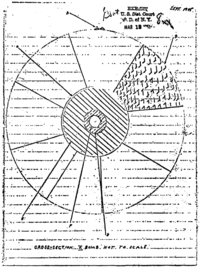David Greenglass
David Greenglass (born March 2, 1922 in New York City , † July 1, 2014 there ) was an American nuclear spy for the Soviet Union.
Life
His parents, Barnet and Tessie, were Jewish refugees from Russia and Austria. He was recruited for Soviet espionage by his wife Ruth Greenglass (née Printz) at the instigation of his brother-in-law Julius Rosenberg . The Rosenbergs were executed on June 19, 1953 in an electric chair in Sing Sing State Prison in New York for nuclear espionage for the Soviet Union . The trial coincided with massive persecution of communists and sharp anti-communism in the US in public and in the investigative committee of the US Senate chaired by McCarthy ( McCarthy era ).
Greenglass, like Rosenberg's, was attached to communist ideas. His wife was 17 years old when they married in 1942. Just before Greenglass joined the US Army in 1943, the couple became members of the Young Communist League. A talented machinist, Greenglass was assigned to the Army Base in Jackson, Mississippi, as a sergeant on the secret Manhattan Project , a war project to develop the first atomic bomb . He was initially employed on the uranium enrichment project in Oak Ridge , Tennessee, before he was later transferred to the secret laboratories of Los Alamos , New Mexico .
After Ruth Greenglass learned from her brother-in-law Julius Rosenberg that the Manhattan Project was engaged in developing the first atomic bomb, David Greenglass began to pass on secret nuclear documents to the Soviets through his brother-in-law from November 1944 until he left the military in 1946 . After the war, Greenglass, his brother Bernie and Julius Rosenberg initially ran a repair shop. In the Venona papers , which were handed over to the US military intelligence service and decrypted, they were listed under the real names David and Ruth Greenglass.
In 1950, with the help of the VENONA project , the US and British secret services had discovered that Klaus Fuchs had also worked as a spy for the Soviet Union. Fuchs' confession revealed that he had passed on secret information to Soviet agent Anatoly Yatskov through his American contact Harry Gold from Brooklyn . Harry Gold's trail eventually led to Greenglass and the Rosenbergs, who had also used Harry Gold as a courier.
Greenglass, who was arrested by the FBI for espionage in June 1950, quickly incriminated Julius Rosenberg as a key witness and initially denied the complicity of Ethel Rosenberg, but later changed his testimony to testify against his sister that she had typed the secret reports. As part of an immunity agreement, his wife Ruth was allowed to stay with their two children as a non-convicted “unindicted co-conspirator”. His testimony ultimately resulted in the death penalty against his sister and brother-in-law.
Greenglass' testimony before the court was not released until 1966. The US nuclear scientist and Nobel Prize winner Harold C. Urey had testified in court during this time that Greenglass was unable to pass on anything to anyone about the atomic bomb due to a lack of sufficient knowledge of physics, chemistry and mathematics. The sketch submitted to the court was worthless. When, decades later, thanks to the efforts of attorney Marshall Perlin, chairman of the Rosenberg committee, a large part of the case files became accessible and a new trial leading to the acquittal of the Rosenbergs could be initiated, the presiding judge declared in 1993 that there was no real evidence at the time given a stake by the Rosenbergs.
Greenglass was sentenced to 15 years in prison, of which he served 10 years. After his release in 1960, Greenglass lived under an assumed name in New York City.
literature
- Robert Lamphere, Tom Shachtman: The FBI-KGB War . Random House, New York 1986
- Sam Roberts: The Brother: The Untold Story of Atomic Spy David Greenglass and How He Sent His Sister, Ethel Rosenberg, to the Electric Chair . (Hardcover) 2001, ISBN 0375500138
- Alexander Feklisov, Sergei Kostin: The Man Behind the ROSENBERGs . ISBN 1929631081
Web links
- Konrad Ege: You could have saved yourself. Article commemorating the 50th anniversary of the execution of Ethel and Julius Rosenberg. In: the Friday of June 20, 2003
- Robert D. McFadden: David Greenglass, the Brother Who Doomed Ethel Rosenberg, Dies at 92. Obituary in The New York Times, October 14, 2014 (English)
- Elaine Woo: David Greenglass dies at 92; '40s A-bomb spy who betrayed his sister. Obituary in the Los Angeles Times, October 14, 2014
- David Greenglass, Soviet Spy, Dies at 92. Obituary on the Atomic Heritage Foundation homepage ofOctober 14, 2014 (English)
Individual evidence
- ↑ Ginger Adams Otis: David Greenglass, of Rosenberg spying case, dead at 92. The native New Yorker, who served 10 years in prison for his part in the Cold War spying scandal that centered on atomic bomb secrets, died in the city July 1 according to his nephews who did not publicize the death at the time. In: New York Daily News. October 14, 2014, archived from the original on October 15, 2014 ; accessed on October 15, 2014 (English).
- ^ Helmut Roewer , Stefan Schäfer, Matthias Uhl: Lexicon of secret services in the 20th century . Herbig, Munich (2003); ISBN 3-7766-2317-9
- ↑ Together in death , article from June 18, 2013 by Johanna Lutteroth on Spiegel Online
| personal data | |
|---|---|
| SURNAME | Greenglass, David |
| BRIEF DESCRIPTION | American nuclear spy |
| DATE OF BIRTH | March 2, 1922 |
| PLACE OF BIRTH | New York City |
| DATE OF DEATH | July 1, 2014 |
| Place of death | New York City |

